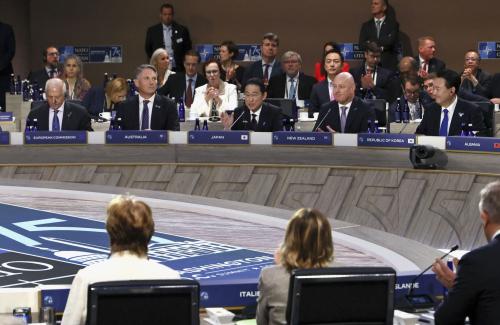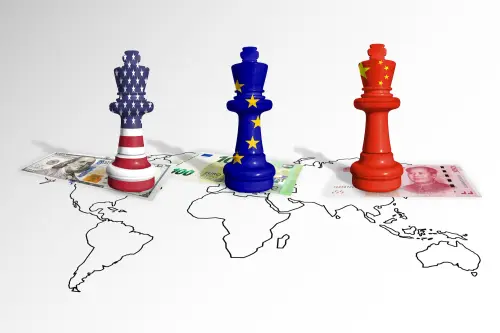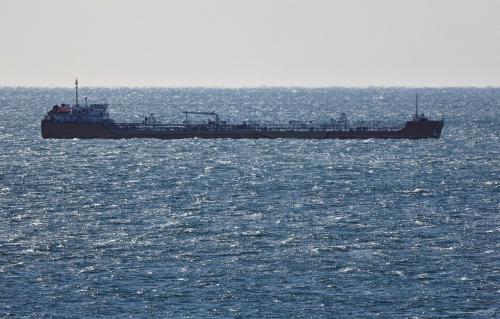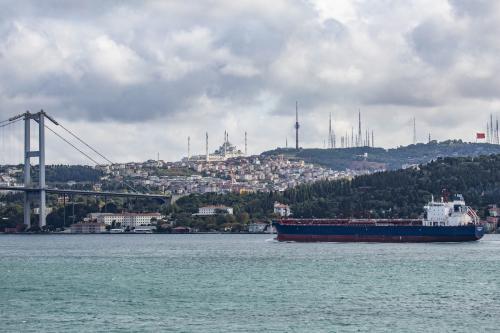The European Union’s (EU) decision to raise its tariffs on Chinese electric vehicles (EVs) has prompted speculation about whether the EU and the United States could cooperatively “de-risk” from China. Much like the United States, the EU has developed a “de-risking” playbook with three goals: to protect its economy from outside encroachments, to promote its own competitiveness and resilience, and to partner with others to amplify its economy’s strengths and mitigate its vulnerabilities. In fact, the term “de-risking” was pioneered by European Commission President Ursula von der Leyen and later embraced by the Biden administration and all G7 leaders.1
Brussels does not use Washington’s de-risking parlance of “protect, promote, and partner,” but that is essentially what it is doing—albeit with European characteristics. There is considerable overlap between the EU and U.S. agendas, but the EU approaches China from a different strategic position, with different tools, and with a different sense of urgency.
The EU’s protect, promote, and partner agenda
Protect
EU countries don’t always agree on how to deal with China. But overall, they have become increasingly hawkish in response to Beijing’s attempts to bully and drive wedges between individual EU member states. They are furious about China’s support for Moscow’s war economy and concerned about China’s violations of human rights and its challenges to Taiwan, to other Asian countries, and to such fundamental principles as freedom of navigation and freedom of information. Fears are growing that Beijing could blackmail Europe by exploiting states’ critical materials dependencies, many of which China controls.
European officials are worried that Chinese industrial overcapacity could generate a wave of cheap, state-subsidized imports that could threaten EU domestic producers. Von der Leyen has threatened the “full use of our trade defense instruments“ if Beijing doesn’t stop such exports. The European Commission has now imposed a provisional set of tariffs on Chinese EV makers that will likely become permanent this fall, unless Beijing finds ways to accommodate EU concerns. That seems unlikely, since China has hit back with its own investigations of EU cognac, dairy, and pork exporters, prompting the EU’s chief diplomat, Josef Borrell, to say that a trade war may be “unavoidable.”
The EU’s “protect” agenda is further complicated because many sensitive sectors are under the jurisdiction of member states rather than the European Commission, the EU’s executive arm. Nevertheless, EU member states added new instruments to their collective “protect” toolbox during von der Leyen’s first five-year term. The commission has used the EU’s new Foreign Subsidies Regulation to investigate several Chinese companies. The EU’s International Procurement Instrument gives the commission the authority to block investment by companies funded by non-EU governments and cut businesses out of procurement contracts if their home market is closed to EU bidders. An Anti-Coercion Instrument allows the commission to apply trade restrictions, customs charges, and other penalties to businesses or countries using coercive tactics. The EU’s Corporate Sustainability Due Diligence Directive obliges firms to ensure human rights and environmental best practices in their supply chains. Under the EU Critical Raw Materials Act, member states have agreed to limit their dependencies on non-EU countries for critical materials. The EU has sharpened its capacity to counteract foreign meddling in innovation and research. It is developing an EU-wide export control system and has expanded its extensive Russia sanctions to entities from China and elsewhere that are supporting Russia’s war economy. Almost all member states have now established inbound investment screening procedures.
Promote
Reacting to three external shocks, the EU has been playing catch-up when it comes to promoting its competitiveness and resilience. The COVID-19 pandemic pushed EU leaders to borrow $1 trillion to help their societies recover. Shortly after that, Russia’s full-scale invasion of Ukraine forced European governments to spend more than $600 billion in one year to counteract the accompanying energy shocks and speed their energy transition. Then, the U.S. passage of the Inflation Reduction Act and the Chips and Science Act stunned Europeans into realizing that the sheer scale of U.S. and Chinese subsidies for clean-tech manufacturing and semiconductor supply chains would create further European dependencies unless they generated their own support schemes. They responded with the Net-Zero Industry Act, the European Chips Act, and the Critical Raw Materials Act, which expedite permitting and facilitate easier access to financing for homegrown cleantech innovations, semiconductor manufacturing, and mining and refining projects.
The bloc has proactively promoted the so-called “Brussels effect“—the belief that member states can shape global standards by establishing common rules for their large single market. Recent examples include the EU’s General Data Protection Regime, Digital Services Act, Digital Markets Act, and the AI Act.
Partner
The EU is also forging new partnerships as part of its “de-risking” agenda. It has stepped up coordination with its G7 partners and supplemented its Trade and Technology Council with the United States with a similar mechanism with India. It has deepened collaboration with Japan on advanced materials—an area of mutual competitive strength. It has pledged to mobilize over $300 billion for infrastructure projects in Africa, Asia, and Latin America. It has signed over a dozen new raw materials deals. It has joined forces with the United States and other like-minded partners to advance Just Energy Transition partnerships with countries like South Africa, Vietnam, and Indonesia. A highly ambitious trade agreement with South America’s Mercosur trade group could be completed by the end of the year, although hurdles remain.
Is it working?
EU industry still maintains its global innovation lead in mechanical engineering and advanced manufacturing, with the United States and China significantly behind. It is strong in life sciences, agriculture and food production, automotives, nanotechnology, energy, and information and communications. It is a global leader in reducing emissions, limiting income inequality, and expanding social mobility.
Nonetheless, Europe’s economy faces many challenges. Capital investments, research and development, and productivity growth have lagged for over a decade. Energy prices remain high. This year, eurozone growth is just 0.3%, and the German economy is stagnant. China is on track to dominate Europe in electrolyzer manufacturing, just as it did with solar and battery technologies. The EU boasts many world-beating innovation clusters but has struggled to translate cutting-edge research and innovation into fast-growing scale-ups. Private investment in AI in the EU last year was only one-eleventh that of the United States (approximately $6 billion vs. $67.2 billion) and lagged that in China ($7.8 billion). Over 60% of venture capital invested in AI so far has flowed to U.S. start-ups, 17% to China, and only 6% to Europe (including both the EU and the U.K.).
Many of the EU’s public-sector initiatives lack adequate funding and strategic deployment. For instance, the Critical Raw Materials Act has no budget—a far cry from the $8.5 billion the United States has allocated to critical raw materials projects. The Foreign Subsidies Regulation has been used to target specific companies rather than strategic sectors. Margrethe Vestager, the EU’s competition chief, has likened the regulation to “playing whack-a-mole.”
In addition, not only is the EU more exposed to China than the United States for both exports and imports, but these imports’ composition has become decidedly more “strategic,” shifting from textiles, shoes, toys, and furniture to electronics, pharmaceutical ingredients, chemicals, rare earths, and other critical raw materials. A recent analysis identified China as the source of approximately one-third of over 200 products in sensitive industrial ecosystems, for which the EU depends on third countries. The EU’s import dependence on China is 90% or higher for certain pharmaceuticals, chemicals, and raw materials. Moreover, most of the EU’s strategic dependencies on China—including magnesium, permanent magnets, photovoltaic cells, and certain antibiotics and hormones—have no substitutes.
Mario Draghi, a former Italian prime minister and European Central Bank president who is leading a study of EU competitiveness, delivers a sobering verdict: the EU’s “organization, decisionmaking and financing are designed for ‘the world of yesterday’ — pre-Covid, pre-Ukraine, pre-conflagration in the Middle East, pre-return of great power rivalry.” He believes public and private investment needs to increase by $542 billion on the digital and green transitions alone if the EU is “to keep pace.”
De-risking 2.0
During von der Leyen’s first term, the EU steadily advanced the “protect” and “partner” elements of its de-risking agenda, but its efforts to promote European competitiveness fell victim to external shocks and internal squabbling. Von der Leyen’s second term offers a fresh start. “De-risking 2.0” needs to prioritize efforts to promote Europe’s competitive strengths, even as the EU protects itself against Chinese encroachments.
Success would be more likely if the EU and the United States collectively harnessed the full potential of the $8.7 trillion trans-Atlantic economy. Yet U.S.-EU relations are beset by competitive impulses and mutual doubts, and the two sides approach the China challenge with different tools and a different sense of urgency. Americans think the Europeans are bringing clubs to a gunfight; Europeans think the Americans are bringing guns to a fistfight.
These differences will likely sharpen if Donald Trump is elected in November 2024. Should Kamala Harris win, both sides will have every reason to jointly turbocharge their robust trans-Atlantic marketplace, drawing in like-minded partners, and not tripping each other up along the way.
The Brookings Institution is committed to quality, independence, and impact.
We are supported by a diverse array of funders. In line with our values and policies, each Brookings publication represents the sole views of its author(s).







Commentary
The EU has a playbook to de-risk from China. Is it working?
September 3, 2024